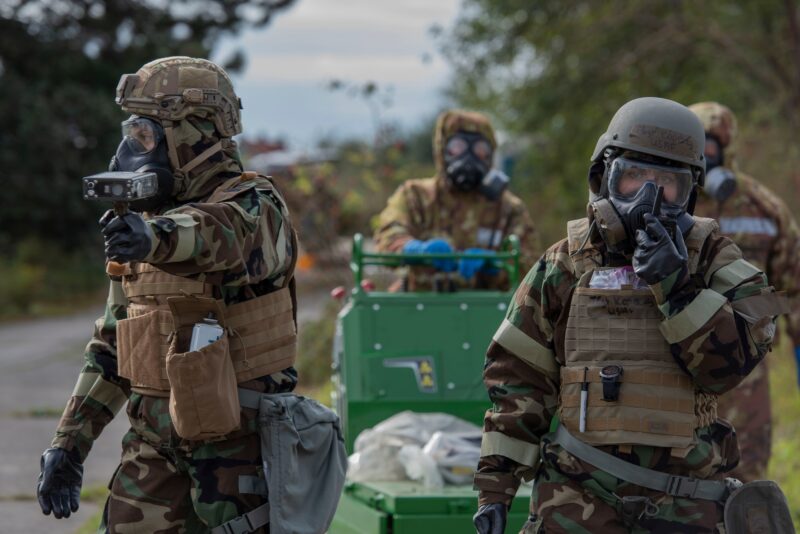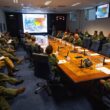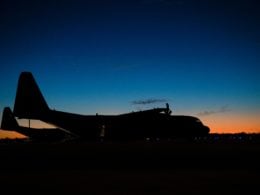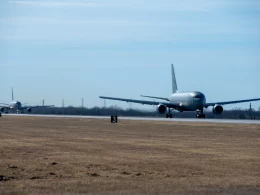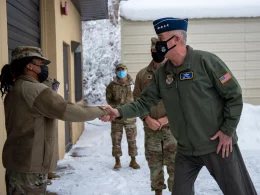KOKSIJDE AIR BASE, Belgium —
KOKSIJDE AIR BASE, Belgium – NATO Exercise Toxic Trip 23, the largest Chemical, Biological, Radiological and Nuclear (CBRN) exercise for NATO allies and partners, was held at Koksijde Air Base, Belgium, Sept. 23-29, 2023, with approximately 500 participants from 18 NATO countries.
Toxic Trip emphasizes the importance of NATO allies and partners collaborating to effectively and rapidly respond to CBRN scenarios, while also providing an opportunity to standardize decontamination systems in the event of a chemical attack or exposure to chemical agents.
“It is a ‘recover the air base’ exercise to practice re-opening an airfield and getting aircraft and pilots back in the fight,” said U.S. Air Force Senior Master Sgt. Michael Lundell, Headquarters U.S. Air Forces in Europe – Air Forces Africa aircrew flight equipment command manager.
In preparation for the exercise, AFE managers with the 86th Operations Support Squadron, 52nd OSS, 31st OSS and 100th OSS, completed an aircrew contamination mitigation course, which allowed them to revise the processes of decontaminating equipment, groundcrew and aircrew after exposure to chemical agents, Lundell said.
Over the course of the exercise, AFE managers employed their knowledge and skills in eight different scenarios by establishing various aircrew contamination control areas and stations in response to chemical and radiological attacks. Lundell said by establishing these stations, AFE managers were able to decontaminate aircrew and groundcrew from fellow NATO nations, to familiarize them with various equipment unique to the U.S. Air Force.
Additionally as part of the exercise, 86th Civil Engineer Squadron, and the 99th CES explosive ordnance disposal teams from Nellis Air Force Base, Nevada, responded to simulated attacks involving vehicles and aircraft with their counterparts from France, Sweden, Italy and Belgium by removing any possible EOD hazards from the scene to ensure the safety of emergency management response teams to fulfill their part in the exercise.
“Participating in this exercise assured our NATO allies of our support, while also enhancing and developing each country’s CBRN competencies by training together,” Lundell said. “Our near-peer threats have these same capabilities. It’s important we exercise together to ensure we know how to work with each other should we have to in a real-world scenario.”
Along with AFE and EOD, additional emergency management teams included those from the 86th Civil Engineer Squadron; 52nd CES, Spangdahlem Air Base, Germany; 341st CES, Malmstrom Air Force Base, Montana; 31st CES from Aviano AB, Italy; 60th CES from Travis AFB, California; and 2nd CES from Barksdale AFB, Louisiana.
To further integrate NATO forces, these EM Airmen ran CBRN reconnaissance and incident control teams who secured the scenes by sampling and identifying various chemical agents, and, when able, performing tactical combat casualty care to injured personnel prior to medical teams’ arrival.
Ultimately, the exercise created common standards, and established uniform procedures for joint operations in the future.
“The exercise was extremely beneficial and allowed each country to demonstrate and observe each other’s capabilities,” Lundell said. “Working to increase interoperability between NATO countries helps seamlessly integrate our forces during joint operations.”
By exercising together, NATO nations are able to ensure NATO’s mission can be fulfilled: to protect the freedom and security of each of its members by political and military means.




